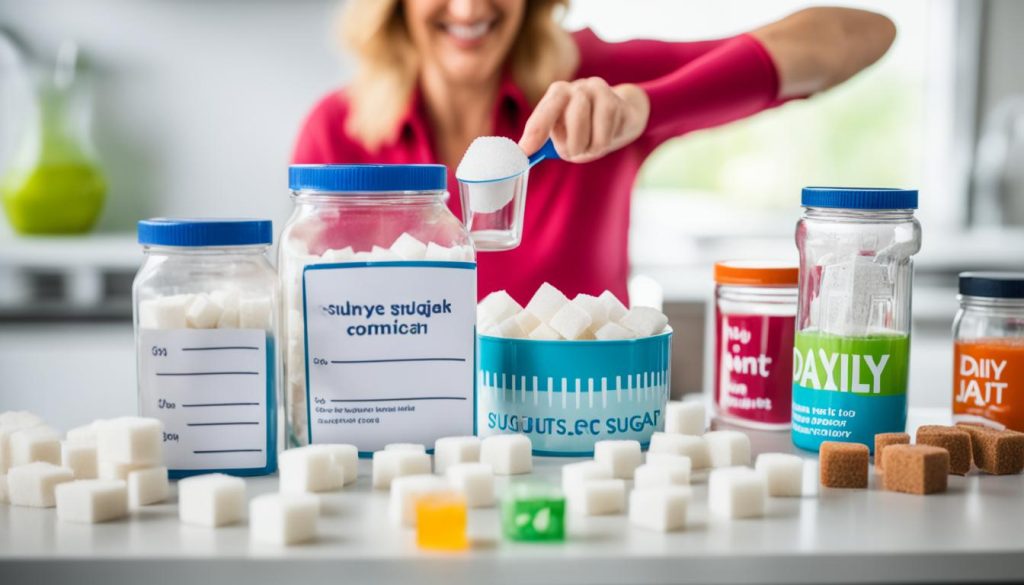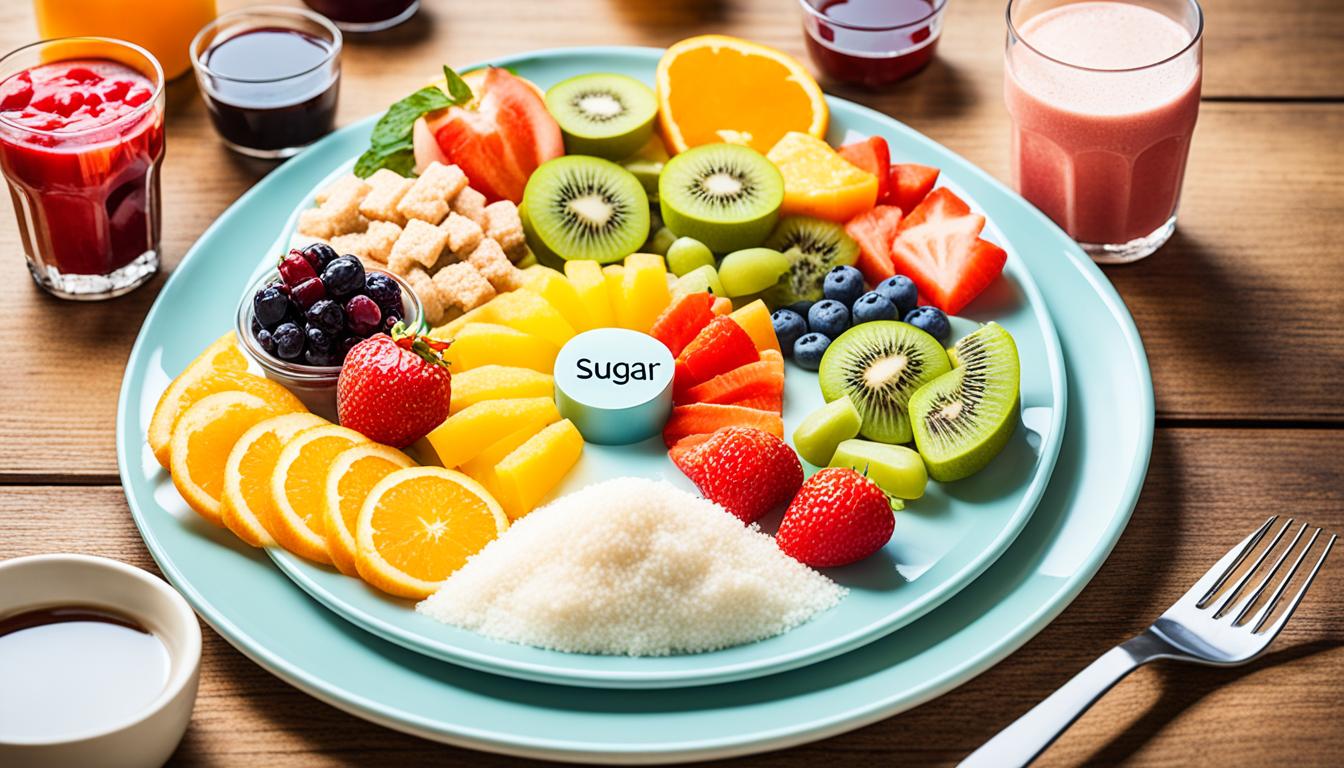Americans consume an average of 17 teaspoons of added sugar every day, which is more than 2-3 times the recommended amount for men and women respectively. Children and young adults aged 2-19 consume 16 teaspoons of added sugar per day. This excessive sugar intake can have negative effects on the body and contribute to health issues such as obesity, heart disease, and type 2 diabetes.
To maintain a balanced diet and overall wellness, it is important for adults to be mindful of their daily sugar intake. The American Heart Association (AHA) recommends that men consume no more than 9 teaspoons of added sugar per day, while women should limit their intake to 6 teaspoons. By understanding the recommended daily sugar allowance and making conscious choices about sugar consumption, adults can take control of their health and well-being.
In this article, we will explore the effects of excessive sugar consumption, the importance of sugar education, the sources of added sugars, and strategies to reduce added sugar intake. By gaining a better understanding of these topics, you will be equipped to make informed choices about your own sugar consumption and improve your overall health.
The Effects of Excessive Sugar Consumption
Consuming too much sugar can have negative effects on the body. When we consume added sugars found in processed foods like soda, they are quickly absorbed by our bodies, leading to a rapid increase in calorie intake. It is essential for adults to be aware of the permissible sugar intake in order to maintain a healthy lifestyle.

How Much Sugar Should an Adults Have in a Day?
The American Heart Association (AHA) recommends that men limit their daily sugar intake to no more than 9 teaspoons, while women should aim for no more than 6 teaspoons of added sugar per day. This recommended sugar intake for adults is essential to prevent potential health issues associated with excessive sugar consumption.
1. Risks of Excessive Sugar Consumption
Excessive sugar consumption has been linked to various health problems, including obesity, heart disease, and type 2 diabetes. Obesity rates in adults are rising due to the overconsumption of added sugars, which are high in calories and promote weight gain. Additionally, an increased risk of heart disease and type 2 diabetes is associated with a high intake of added sugars.
2. Strategies to Reduce Sugar Intake
Reducing added sugar intake can be challenging. However, small changes in our eating habits can make a significant difference in our overall health. It is recommended to read food labels carefully and choose products with low sugar content. Opting for whole foods like fruits and vegetables, which are naturally low in added sugars, is also beneficial. Replacing sugary beverages with water or unsweetened drinks can help tremendously in reducing overall sugar consumption.
Table: Sources of Added Sugars
| Source | Percentage of Total Added Sugars |
|---|---|
| Beverages (soft drinks, fruit drinks) | 47% |
| Snacks and sweets | 31% |
| Grains (cereals, cookies, and pastries) | 13% |
| Dairy products | 5% |
| Fruits (fruit canned in syrup) | 4% |
It is important to note that added sugars can be listed under different names, such as high-fructose corn syrup, honey, and syrup. Reading labels and being mindful of hidden sugars is crucial in maintaining a healthy sugar intake for adults.
The Importance of Sugar Education
Research suggests that 77% of Americans are striving for less sugar in their diets, and 7 in 10 consumers are willing to give up sugary products for healthier alternatives. This increasing awareness of the impact of sugar on health has led to the establishment of sugar guidelines for adults. Understanding and adhering to adult sugar consumption guidelines is crucial for maintaining a healthy lifestyle.
One of the key developments in sugar education is the requirement for food manufacturers to list the amount of added sugars on nutrition labels. This labeling change has made it easier for consumers to determine how much sugar a product contains. By providing clear information on the percentage of daily sugar allowance for adults, consumers can make informed choices about their sugar intake.

By labeling added sugars, food manufacturers are contributing to the prevention of nearly 1 million cases of cardiovascular disease and type 2 diabetes over the next two decades. This initiative highlights the importance of understanding and adhering to daily sugar allowance for adults to reduce the risk of chronic diseases.
With the availability of information on sugar guidelines for adults, individuals can take control of their health and make conscious decisions to manage their sugar consumption. By replacing sugary products with healthier alternatives and opting for products with lower added sugar content, adults can gradually reduce their sugar intake and improve their overall well-being.
Sources of Added Sugar
When it comes to added sugars, beverages, especially soft drinks, are the primary culprits, accounting for a whopping 47% of all added sugars consumed by adults. Fruit drinks, sport/energy drinks, and coffee/tea also contribute to the intake of added sugars. However, it’s not just drinks that are to blame. Snacks and sweets, such as cookies and pastries, are the second-largest contributors to added sugar consumption.
To make matters more complex, added sugars can be listed under various names on ingredient lists. High-fructose corn syrup, honey, and syrup are just a few examples of the different aliases added sugars may go by. That’s why it’s crucial for adults to read ingredient labels carefully and familiarize themselves with the various names for added sugars.
To give you a clearer picture, here’s a breakdown of the sources of added sugars:
| Source | Percentage of Added Sugars |
|---|---|
| Soft Drinks | 47% |
| Fruit Drinks | 17% |
| Sport/Energy Drinks | 8% |
| Coffee/Tea | 8% |
| Snacks and Sweets | 20% |
Understanding the sources of added sugars can help adults make more informed choices and be mindful of their sugar intake.
How to Reduce Added Sugar Intake?
Reducing added sugar intake is an important step towards maintaining a healthy lifestyle. By making smart swaps and choosing healthier options, you can effectively cut down on your daily sugar intake. Here are some practical tips:
- Replace sugary cereals with unsweetened options: Opt for whole-grain cereals or muesli without added sugars. Add fresh fruit, like berries or sliced banana, for a natural and nutritious sweetness.
- Choose water or low-fat milk instead of sweetened beverages: Sugary drinks, such as soda and fruit-flavored drinks, are a major source of added sugars. Hydrate with water, unsweetened herbal tea, or low-fat milk instead.
- Read labels to identify added sugars: Pay attention to ingredient lists when shopping. Added sugars can appear under different names, such as high-fructose corn syrup, honey, or syrup. Be aware of different aliases to make informed choices.
- Reduce sugar added to coffee or tea: Gradually decrease the amount of sugar you add to your beverages. Alternatively, try using plant-based sweeteners like stevia or monk fruit extract for a low-calorie but sweet alternative.
By implementing these small changes, you can gradually reduce your daily sugar intake and promote better health. Remember, it’s all about making mindful choices and finding healthier substitutes that still satisfy your taste buds.

Spotting Added Sugars on Food Labels
When it comes to managing our sugar consumption, being able to identify added sugars on food labels is essential. The updated Nutrition Facts label now makes it easier than ever to spot these sugars and make more informed choices about our daily intake.
One important change is the inclusion of both “Total Sugars” and “Added Sugars” on the label. This distinction is crucial because it helps us differentiate between the natural sugars present in foods, such as fruit, and the additional sugars that are added during processing.
The percent Daily Value (DV) for added sugars is based on the recommended limit of less than 10% of total calories, according to sugar consumption guidelines for adults. This means that we should aim to keep our added sugar intake within this limit to maintain a balanced diet.
Reading the ingredient list on food labels is another useful tool for identifying added sugars. Ingredients are listed in descending order by weight, so the higher an added sugar appears on the list, the more of it the product contains. However, it’s important to note that added sugars can go by many names, so being aware of these aliases is crucial. Some common names for added sugars include high-fructose corn syrup, honey, and syrup.
Spotting Added Sugars: A Quick Guide
To help you identify added sugars more easily, here’s a quick guide:
- Check the “Total Sugars” and “Added Sugars” sections on the Nutrition Facts label.
- Keep an eye on the percent Daily Value (DV) for added sugars.
- Scan the ingredient list and look for any of the common names that are used for added sugars.
Common Names for Added Sugars
| Name | Description |
|---|---|
| High-fructose corn syrup | A sweetener made from corn starch that is commonly used in processed foods and soft drinks. |
| Honey | A natural sweetener derived from bees that is often added to various food products. |
| Syrup | A thick, sweet liquid that is commonly used to sweeten pancakes, waffles, and other foods. |
| Molasses | A thick, dark syrup that is produced during the sugar-making process and used as a sweetener. |
By understanding how to spot added sugars on food labels, we can make more informed choices about our daily sugar intake, in line with the recommended daily sugar allowance. Taking control of our sugar consumption is a small but significant step towards maintaining a healthier lifestyle.

Conclusion
To maintain a balanced diet and overall wellness, it is recommended that adults limit their daily sugar intake. Men should aim for no more than 9 teaspoons of sugar per day, while women should aim for 6 teaspoons. Consuming excessive amounts of sugar can have negative health effects, including obesity, heart disease, and type 2 diabetes.
By being mindful of added sugars in beverages and processed foods, reading labels, and making small dietary changes, adults can reduce their sugar intake and improve their overall health. Start by substituting sugary cereals with unsweetened options and adding fresh fruit for natural sweetness. Choose water or low-fat milk over sweetened beverages, and carefully read ingredient lists to identify hidden sugars.
Remember, reducing sugar intake doesn’t mean sacrificing taste. Small changes like reducing added sugar in coffee or using plant-based sweeteners can make a significant difference. By making informed choices and being conscious of sugar consumption, adults can take control of their health and enjoy a well-balanced diet.




